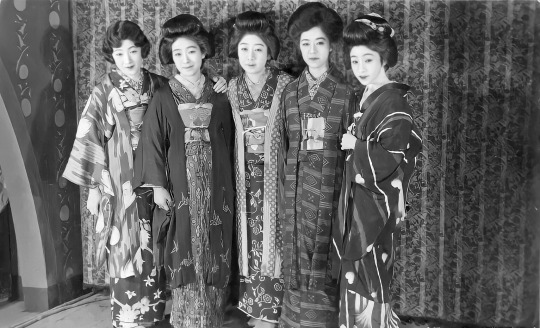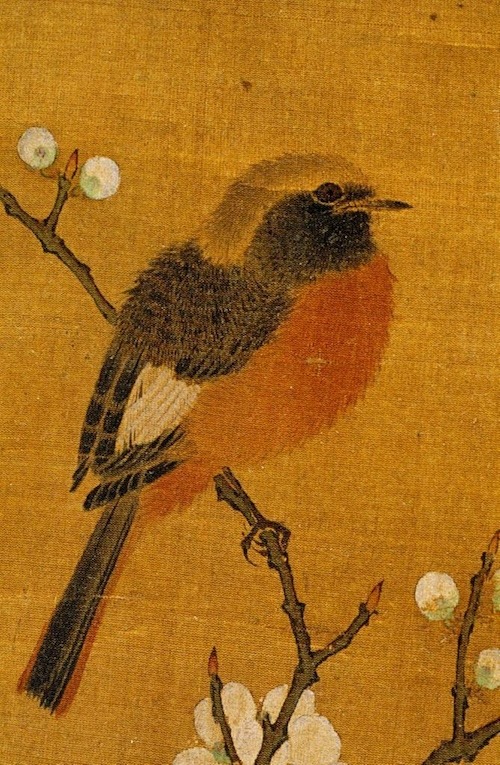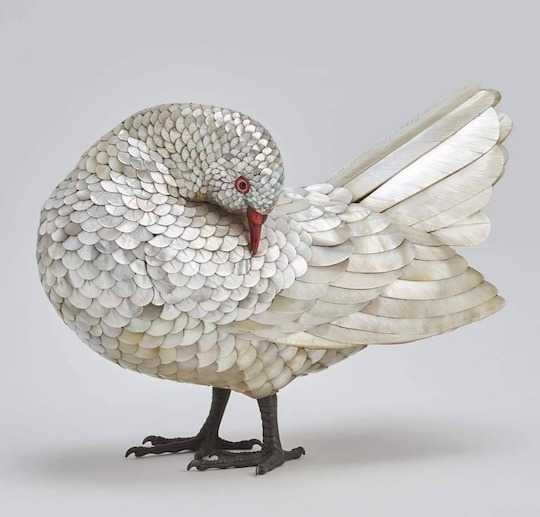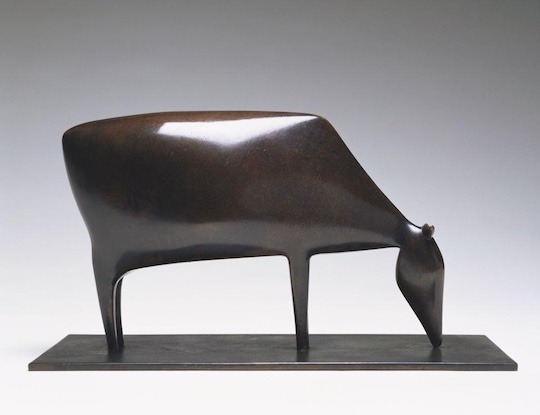#20th c. Japan
Explore tagged Tumblr posts
Text

Japanese actresses Sumiko Kurishima, Chieko Matsui, Yoshiko Kawada, Yukiko Tsukuba and Sakuko Yanagi, 1926
105 notes
·
View notes
Text
~ Monthly BL Breakdown: December 2024 ~
🎆 Happy New Year!!! 🎉
Hey everyone! This will be my last breakdown as I have decided to discontinue the tradition. Making compilation posts requires a lot of work and dedication and unfortunately the engagement is not big enough for me to have the motivation to keep going. Thank you to those who have liked and reblogged and said nice things, I appreciate that very much!! 🧡 I will continue to run my blog as usual so I will remain available for asks about anything (as long as they're nice) and I will continue to post updates here and there. Thank you 🧡
Disclaimer: ALL shows can be streamed here or here, as well as on Youtube and other platforms. For more info on where to watch what, check out this post!
As always feel free to add stuff! -> previous breakdowns

What came out this month? (green = seen/currently watching)
🌟 Addicted Heroin Special Episode - December 1st (Thailand)
🌟 Tokimeki Bomb - December 1st (Japan)
🌟 Hidden - December 3rd (Thailand)
🌟 You Want Some? - December 5th (South Korea)
🌟 Be Moon - December 6th (China)
🌟 Eyes on You - December 11th (Hong Kong)
🌟 ThamePo: Heart that Skips a Beat - December 13th (Thailand) ✅
🌟 The Renovation - December 14th (Thailand)
🌟 Only For Fans - December 15th (South Korea)
🌟 Eternal Butler - December 20th (Taiwan)
🌟 Gangster And His Boyfriend - December 21st (South Korea)
🌟 The Way Home - December 24th (China)
🌟 Sangmin Dinneaw - December 29th (Thailand)
Monthly Likes / Dislikes
❣️ - ø 👎🏻 - ø
New series & movie announcements
🎥 Lost on the River (starring JudoFluke) - Date TBA (Thailand)
🎥 I'm Not Wrong - Date TBA (South Korea)
🎥 Love Destiny from Hell - Date TBA (Thailand)
🎥 Concealed and Blended - Date TBA (Thailand)
🎥 City of the Sun - Date TBA (China)
🎥 Secret Relationship - Date TBA (South Korea)
🎥 Love and Punishment - Coming March 2025 (Taiwan)
🎥 Desire - Date TBA (China)
Other news from the BL world
❗️ The winners of GMMTV's BL contest Y-Find have been announced. A total of 4 submitted plots by Thai fans will be adapted into series. The winning titles are My Lovely Pet, Who Killed My Boo?, Lost Time and รักนี้พอดีเป็นของพระรอง. Further production steps have not been disclosed by the company.
❗️ The Japanese BL I Became the Lead in a BL Drama is getting a sequel. The title as well as a premiere date have not been announced.
❗️ The Japanese lgbt dating reality show The Boyfriend is getting a second season. Further details are unknown.
❗️ Former Be On Cloud actor Barcode Tinnasit has joined GMMTV.
❗️ In a public statement, the writer of the novel Pit Babe, which was adapted into a series in 2023, announced that they have removed the Omegaverse elements from the sequel as it no longer complies with their beliefs and principles. These changes will be carried into the upcoming series adaption by Change 2561 in 2025.
❗️ The yearly Y Entertainment Awards were held on December 1st. The following BL actors/productions won:
Last Twilight: Best BL of the Year
Aof Noppharnach: Best BL director of the Year
Pooh Krittin: BL Prince of the Year
Pit Babe: Best Production of the Year
"Re-Move On" by GeminiFourth: Best OST of the Year (My Love Mixup)
Up Poompat: Best BL Lead Actor of the Year
❗️ WETV released their 2025 lineup on December 5th. The following BL productions were announced:
Shine (sequel to ManSuang, starring Mile P. and Apo N.)
Love of Silom (starring Up P. and Poom P.)
Top Form (adaption of the manga Dakaichi, starring Smart C. and Boom R.)
Knock Out (starring Gunner N. and Nice B.)
Me and Who (collaboration with Domundi, starring Big T. and Park A.)
Upcoming series & movies for January:
👉🏻 The Boy Next World - January 5th (Thailand)
👉🏻 Ossan's Love Thailand - January 6th (Thailand)
👉🏻 When It Rains It Pours - January 9th (Japan)
👉🏻 Idolfactory 2025 lineup event - January 12th (Thailand)
👉🏻 Impression of Youth - January 15th (Taiwan)
#doreens monthly bl breakdown#thai bl#bl drama#upcoming bl#update#bl news#thank you for supporting my breakdowns! 🧡#i had fun with them#happy new year!!! wishing everyone love and happiness and health!!
74 notes
·
View notes
Text
I reckon this snowman is a relatable mood to many today…

New Year's Card: Snowman, Crow, and Sun Japan, Late Meiji era (late 19th / early 20th c.) Color lithograph; ink on card stock 13.8 x 8.8 cm (5 7/16 x 3 7/16 in) Museum of Fine Arts, Boston 2002.18292
#animals in art#20th century art#birds in art#19th century art#bird#crow#corvid#Japanese art#Asian art#East Asian art#card#New Year’s card#holiday card#greeting card#Happy New Year#lithograph#print
81 notes
·
View notes
Text
Japanese Insired Coats of the 1910s

Maison Amy Linker • Paris
A coat with a silhouette like an outer robe for kimono was described as a “manteau japonais” by fashion magazines of the time, and the silhouette of this particular coat is reminiscent of the “uchikake” robe worn by kabuki actors or oiran courtesans in ukiyoe prints. The boldly striped collar is probably inspired by the “date-eri” collar style used in kabuki costume. The flower-like motifs executed in embroidered beads look like the traditional “hanakatsumi” motif that became popular in late Edo-period Japan when favored by kabuki actors. In contrast, the motifs on the bordered panel on the back resemble motifs used around the Mediterranean in ancient times, and could reasonably be called palmettes. This coat is an excellent example of oriental-style wear packed with eclectic elements that were fashionable early in the 1910s. Maison Amy Linker opened in Paris in 1900, specializing particularly in coats and suits. Its latest products were frequently seen in French fashion magazines early in the 20th century. The house is perhaps best known for introducing sporty fashions in the 1920s.
Many of the era's most prominent designers created manteau Japonais. Below are a few more examples of Japanese inspired cocoon coats of the era.


Two Paul Poiret Japonaise manteau

Jean-Philippe Worth • c. 1910


Right: Jaques Ducet embellished house coat
Left: Mariano Fortuny kimono coat • 1910s

Evening coat • French • c. 1912
#fashion history#women's fashion history#1910s fashion#edwardian fashion#cocoon coat#vintage designer fashion#jacques ducet#mariano fortuny y madrazo#house of worth#amy linker#paul poiret#paris fashion of 1910s#the resplendent outfit blog#fashion blogs on tumblr
55 notes
·
View notes
Text
Bandai Japan Details 2024 Tamagotchi Ichiban Kuji

Back for a second year, and better than ever!


We already knew the lottery, known as the Ichiban Kuji was coming back for 2024 from the announcement back in July, 2024, and we’ve been drooling over the recent pictures of the prizes at the 2024 Tokyo Toy Show.







Now, Bandai Japan has detailed all of the prizes officially on the Tamagotchi Ichiban Kuji website!

Prize A is that beautiful Tamagotchi Connection limited edition Ichiban Kuji shell.

Prize B is a large Tamagotchi Mametchi clear case, which is perfect for storing things, with a large capacity so you can see what is inside.

Prize C are Tamagotchi pouches, which feature characters on top of them and a clear circular case with a keychain.

Prize D are Tamagotchi Connection card holders a total of six designs from the Entomb and Uratama era!

Prize E are Tamagotchi acrylic keychains, a total of six designs ranging from Tamagotchi Connection themed, to a Tamagotchi iD themed one too!

Prize F are die-cut towels with Tamagotchi Ichiban Kuji graphics on them! Featuring the Tamagotchi Connection 20th Anniversary graphic, Keitai Tamagotchi, and even some vintage screen sprites too.

Prize G consists of Tamagotchi zipper bags, in various deigns, perfect for storing small items, and phone tab and decorative stickers.






Last prize is the large 60cm Kuchipatchi Hug Plush! Super cute, super soft, and features a Tamagotchi Connection 20th Anniversary logo on him too!
You know the routine, the Ichiban Kuji starts in Japan on November 22nd, 2024 at various retail locations (Lawson, Ichiban Kuji Official Shop, Ichiban Kuji Online). Simply locate a store display, purchase a ticket and see which prize you earn! Tickets are ¥700 including tax. The Ichiban Kuji will run until February, 2025! Good luck!
56 notes
·
View notes
Text
[A]nti-homeless laws [...] rooted in European anti-vagrancy laws were adapted across parts of the Japanese empire [...] at the turn of the 20th century. [...] [C]riminalising ideas transferred from anti-vagrancy statutes into [contemporary] welfare systems. [...] [W]elfare and border control systems - substantively shaped by imperial aversions to racialised ideas of uncivilised vagrants - mutually served as a transnational legal architecture [...] [leading to] [t]oday's modern divides between homeless persons, migrants, and refugees [...].
---
By the Boer Wars (1880–1902), Euro-American powers and settler-colonial governments professed anxieties about White degeneration and the so-called “Yellow Peril” alongside other existential threats to White supremacy [...]. Japan [...] validated the creation of transnational racial hierarchies as it sought to elevate its own global standing [...]. [O]ne key legal instrument for achieving such racialised orders was the vagrancy concept, rooted in vagrancy laws that originated in Europe and proliferated globally through imperial-colonial conquest [...].
[A]nti-vagrancy regulation [...] shaped public thinking around homelessness [...]. Such laws were applied as a “criminal making device” (Kimber 2013:544) and "catch-all detention rationale" (Agee 2018:1659) targeting persons deemed threats for their supposedly transgressive or "wayward interiority" (Nicolazzo 2014:339) measured against raced, gendered, ableist, and classed norms [...]. Through the mid-20th century, vagrancy laws were aggressively used to control migration [and] encourage labour [...]. As vagrancy laws fell out of favour, [...] a "vagrancy concept" nonetheless thrived in welfare systems that similarly meted out punishment for ostensible vagrant-like qualities [...], [which] helps explain why particular discourses about the mobile poor have persisted to date [...].
---
During high imperialism (1870–1914), European, American, and Japanese empires expanded rapidly, aided by technologies like steam and electricity. The Boer Wars and Japan's ascent to Great Power status each profoundly influenced trans-imperial dynamics, hardening Euro-American concerns regarding a perceived deterioration of the White race. [...] Through the 1870s [...] the [Japanese] government introduced modern police forces and a centralised koseki register to monitor spatial movement. The koseki register, which recorded geographic origins, also served as a tool for marking racialised groups including Ainu, Burakumin, Chinese, [...] and Korean subjects across Japan's empire [...]. The 1880 Penal Code contained Japan's first anti-vagrancy statute, based on French models [...]. Tokyo's Governor Matsuda, known for introducing geographic segregation of the rich and poor, expressed concern around 1882 for kichinyado (daily lodgings), which he identified as “den[s] for people without fixed employment or [koseki] registration” [...].
Attention to “vagrant foreigners” (furō-gaikokujin) emerged in Japanese media and politics in the mid-1890s. It stemmed directly from contemporary British debates over immigration restrictions targeting predominantly Jewish “destitute aliens” [...].
The 1896 Landing Regulation for Qing Nationals barred entry of “people without fixed employment” and “Chinese labourers” [...], justified as essential "for maintaining public peace and morals" in legal documents [...]. Notably, prohibitions against Chinese labourers were repeatedly modified at the British consulate's behest through 1899 to ensure more workers for [the British-affiliated plantation] tea industry. [...]
---
Simultaneously, new welfaristic measures emerged alongside such punitive anti-vagrancy statutes. [...] Such border control regulations were eventually standardised in Japan's first immigration law, the 1918 Foreigners’ Entry Order. [...] This turn towards instituting racialised territorial boundaries should be understood in light of empire's concurrent welfarist turn [...]. Japanese administration established a quasi-carceral workhouse system in 1906 [in colonized territory of East Asia] [...] which sentenced [...] vagrants to years in workhouses. This law still treated vagrancy as illegal, but touted its remedy of compulsory labour as welfaristic. [...] This welfarist tum led to a proliferation of state-run programmes [...] connecting [lower classes] to employment. Therein, the vagrancy concept became operative in sorting between subjects deemed deserving, or undeserving, of aid. Effectively, surveillance practices in welfare systems mobilised the vagrancy concept to, firstly, justify supportive assistance and labour protections centring able-bodied, and especially married, Japanese men deemed “willing to work” and, secondly, withhold protections from racialised persons for their perceived waywardness [...] as contemporaneous Burakumin, Korean, and Ainu movements frequently protested [...]. [D]uring the American occupation (1945–1952), not only were anti-vagrancy statutes reinstituted in Japan's 1948 Minor Offences Act, but [...] the 1946 Livelihood Protection Act (Article 2) excluded “people unwilling to work or lazy” from social insurance coverage [...].
---
Imperial expansion relied on not only claiming new markets and territories, but also using borders as places for negotiating legal powers and personhood [...]. Japan [...] integrated Euro-American ideas and practices attached to extraterritorial governance, like exceptionalism and legal immunity, into its legal systems. [...] (Importantly, because supportive systems [welfare], like punitive ones, were racialised to differentially regulate mobilities according to racial-ethic hierarchies, they were not universally beneficial to all eligible subjects.) [...]
At the turn of the century, imperialism and industrial capitalism had co-produced new transnational mobilities [which induced mass movements of poor and newly displaced people seeking income] [...]. These mobilities - unlike those celebrated in imperial travel writing - conflicted with racist imaginaries of who should possess freedom of movement, thereby triggering racialised concerns over vagrancy [...]. In both Euro-American and Japanese contexts, [...] racialised “lawless” Others (readily associated with vagrancy) were treated as threats to “public order” and “public peace and morals”. [...] Early 20th century discourse about vagrants, undesirable aliens, and “vagrant foreigners” [...] produced [...] "new categories of [illegal] people" [...] that cast particular people outside of systems of state aid and protection. [...] [P]ractices of illegalisation impress upon people, “the constant threat of removal, of being coercively forced out and physically removed [...] … an expulsion from life and living itself”.
---
All text above by: Rayna Rusenko. "The Vagrancy Concept, Border Control, and Legal Architectures of Human In/Security". Antipode [A Radical Journal of Geography] Volume 56, Issue 2, pages 628-650. First published 24 October 2023. [Bold emphasis and some paragraph breaks/contractions added by me. Text within brackets added by me for clarity. Presented here for criticism, teaching, commentary purposes.]
158 notes
·
View notes
Text






























portrayals of bats in the 20th & 21st centuries
Bat Cabaret Sign - France - wrought iron, rolled iron, carved and embossed, green glass
pair of bats - ivory seal - China
Rene Lalique (French, 1860-1945) - bat brooch - 1900
bat design - Bijutsukai (Art World) - vol. 2 - 1901-1902
Rene Lalique (French, 1860-1945) - bat ring - 1901
Rene Lalique (French, 1860-1945) - bat pendant - 1901
Ferdinand Erhart (French, active 1891-1933) - Bat Belt Buckle - cast silver, carved and oxidized - 1908
Bat Brooch - France - c.1908
Henri Husson (French, 1852-1933) - Cup with Bat - c.1909
Ohara Koson (Japanese, 1877-1945) - Bats In Moonlight - c.1910
Harrison Cady (American, 1877-1970) - illustration for Mother West Wind Why Stories by Thornton Burgess - 1915
John Buckland Wright (British, 1897-1954) - illustration for Le Sphinx by Iwan Gilkin - 1919
Heinrich Kley (German, 1863-1945) - illustration for Der Orchideengarten (The Orchid Garden) - 1919
Bats and Crescent Moon - incense box - Japan - early 20th century
Weird Tales - October 1933
Black Bat Firecrackers
Edward Gorey (American, 1925-2000) - Bat & Ballerina - pin - New York City Ballet - c.1970s
Edward Gorey (American, 1925-2000) - Bats & Bicycles stencil illustration from The Broken Spoke - 1976
Edward Gorey (American, 1925-2000) - cover illustration for A Clutch of Vampires by Raymond T. McNally
Three of Bats - Tarot Card - 1996
Richard Cooluris (American, working in San Francisco) - Perseus and the Bat - mixed media painting on wood panel - 2016
Yegor Smirnov (working in Montreal) - Bat Ring - 3d-printed and casted in silver - 2016
Stephanie Inagaki (working in Los Angeles) - Trinity - charcoal & gold foil
Adam Binder (British, b.1970) - Bats - carved ebony & carved ivory
Wayan Tuges (luthier working in Indonesia) - Raised by Bats - Commemorative custom Blueberry guitar for Aurelio Voltair - 2020
#art by others#other's artwork#sculpture#painting#jewelry#lamp#guitar#illustration#box#drawing#tarot#book cover#pin#firecracker#seal#René Lalique#Ferdinand Erhart#Henri Husson#Ohara Koson#Edward Gorey#Harrison Cady#John Buckland Wright#Heinrich Kley#Yegor Smirnov#Stephanie Inagaki#Adam Binder#Wayan Tuges#Richard Cooluris
32 notes
·
View notes
Text

Thanks to Ingek73 for finding this unusual apt. in Amsterdam that spans across 3 buildings. They broke thru the walls of the 3 buildings, highlighted in the photo, that together traverse 5 centuries. 2bds, 2ba - €2.650M / $2.810M

The entrance is in the newest building that was built in the 20th century.

There are stairs and an elevator to the spacious apt.

There's a large walk-in cloak room next to the kitchen.

The kitchen description says that when the cabinets are opened with electric controls, it suddenly becomes a warm space with the special table and bench specifically designed for it. Wish they showed it.

Thru the kitchen doors is the living room space.

I suppose that the steps are here b/c the two buildings' floors didn't line up.

The description also states that this Zen apt.'s design and furnishings are aimed at maintaining a very spacious and minimalist appearance.

The emphasis is on avoiding unnecessary objects and creating an oasis of peace. Most furniture is handmade by craftsmen in Amsterdam and Japan. Each piece is specifically designed for the space and contributes to the overall harmony and aesthetics of the interior.

Natural materials, such as limestone, washi paper, cedar, French oak, American walnut and jute, have been used to create a connection with nature.


French doors create a conservatory-like ambiance. The dining room can be closed off with double doors or kept open in connection with the sitting room when entertaining.


From the dining room there's access to one of the two bedrooms and the hall with adjacent study room.


Both bedrooms have identical bathrooms.

The second bedroom at the rear has a special element that they don't show- a glass window in the dividing wall between the bathrooms can be changed from opaque to transparent at the touch of a button

The front entrance to the apt. is in the building on the right.

The view of the canal from the eight windows makes this apartment rare.
163 notes
·
View notes
Text
Russia has had significantly more women than men for decades. The country’s 2020 census found that women and girls made up about 54 percent of Russia’s population, while men made up about 46 percent. Since February 2022, this gender gap has almost certainly become even more pronounced, as more than 120,000 Russian men have been killed in the war against Ukraine. Journalists from the independent outlet Cherta Media spoke to demographers and sociologists about why Russia has had such a gender imbalance for so long — and how the invasion of Ukraine is affecting the situation. Meduza shares an abridged translation of their report.
Worldwide, about 105 boys are born for every 100 girls. At the same time, early childhood mortality is higher among boys than among girls. As a result, even with the small “head start” for boys, the ratio of boys to girls (and later men to women) within each generation becomes smaller over time, and by a certain age, the number of women in a given age cohort typically surpasses the number of men. But while in Japan, for example, this happens at about 56 years old, in Russia it happens at around 30.
Life expectancy is lower for men than for women in nearly every country in the world. In some countries, however, this difference is merely three or four years, while in others, it can reach 10 years or more. The latter scenario is especially common for post-Soviet countries.
In 2022, Russia became the country with the largest difference between the life expectancies of men and women: on average, men live nearly 11 years less. The result is a population gap of about 10 million: 68.4 million men vs. 78.8 million women. And the war only promises to exacerbate the disparity.
Why are there fewer men than women in Russia?
While it’s commonly believed that Russia’s gender imbalance stems directly from the turmoil of the early 20th century (when it experienced the Russian Civil War, the world wars, and the mass repressions of the 1930s), these events don’t explain why the gap persists, according to demographer Alexey Raksha. This is because while a majority of the people dying in them were men, the youngest surviving participants are currently over 95 years old. In the second half of the last century, meanwhile, there were no wars that significantly impacted the country’s demographic situation; even the Afghan War and the Chechen Wars killed a relatively small portion of Russia’s population.
In fact, the current imbalance is due to the high rate of male deaths due to everyday causes, such as murders, suicides, car crashes, and other fatal accidents. Male mortality from chronic diseases is also exceptionally high, and many Russian men lead lifestyles that accelerate the progression of these diseases, Raksha says. The death rate from cardiovascular diseases among men aged 16–59, for example, is 3.1 times higher than among women of the same age.
“One major factor here is toxic masculinity — a kind of male behavior that’s prevalent in certain countries, including Russia,” sociologist Irina Tartakovskaya tells Cherta. “Men in these countries often pay less attention to their health because it doesn’t fit their idea of a ‘real man,’ the idea that one should be strong and ignore any ailment they’re suffering from. This model leads to risky behavior among men: involvement in criminal activity, aggressive driving, and, as a result, car accidents — all of which increase male mortality.”
But the biggest reason for the high mortality rate among men is alcohol abuse. “Every year, at least 150,000–200,000 people die in Russia due to alcohol, and about 80 percent of them are men,” Raksha says. “Alcohol leads to the development of various fatal illnesses, from liver cirrhosis to cardiovascular diseases, and often triggers external causes of death as well. For example, a majority of murders are committed under the influence of alcohol.” He notes that Soviet leader Mikhail Gorbachev’s anti-alcoholism campaign in the 1980s led to a 3.5-year increase in male life expectancy.
“From 2006 to 2018, the consumption of life-threatening beverages decreased as people began switching to ‘lighter’ alcohol,” Raksha explains. “However, the situation changed drastically due to the ‘vodka lobby.’ In the 2010s, [the authorities] ‘cracked down’ on beer and other low-alcohol drinks, imposing new customs duties and increasing excise taxes on them but not on stronger beverages. By the start of 2024, the situation had become even worse: the full force of excise taxes and duties, along with further legal restrictions, had hit wine, beer, and low-alcohol beverages the hardest, while duties on cheap imported liquor didn’t just remain the same but were lowered. As a result, people gradually started returning to stronger drinks like domestic whiskey, which inevitably leads to an increase in mortality.”
The high prevalence in Russia of alcoholism and tobacco use — another major contributor to the high male mortality rate — is attributable to the country’s social conditions, Tartakovskaya says. According to her, most Russians have few opportunities for social mobility or maintaining a high quality of life, which leads them to engage in destructive behaviors to cope with the stress.
What role does the Soviet past play?
In the 1960s, male mortality began rising in all socialist countries, while female mortality, if it increased at all, rose at a much lower rate. The mortality gap widened, and this trend has persisted ever since. According to a British study from 1996, the difference between mortality rates in Eastern Europe and those in Western Europe was primarily a result of differing behavioral patterns: neglecting one’s personal health, as well as alcohol and tobacco addiction, were particularly common among men in socialist bloc countries.
Analysts from the think tank To Be Precise have identified several factors that they say likely contributed to the higher levels of destructive behaviors in these countries. These include:
Ideological norms that prioritized societal interests over individual well-being and promoted the idea that “life should include an element of heroism”;
A higher share of the population doing hazardous jobs or working in facilities with unhealthy conditions;
The media’s promotion of the ideal man as someone strong who never complains.
“Ideas about masculinity differed between socialist and capitalist countries. In capitalist societies, men could assert themselves by starting businesses, building careers, and making profits. Someone with these aspirations would take care of his health, as it was an important tool for his success,” Tartakovskaya says. “But there was no equivalent in socialist societies. The pursuit of personal success and good earnings was frowned upon as ‘careerism’ and seen as a denial of societal norms and values. This meant that men could assert themselves only through service to the state, often at the expense of their health.”
These, along with other societal patterns with roots in the Soviet period, have been “absorbed” into the cultures and lifestyles of people in former socialist countries and continue to affect them today: in almost all such countries, men live significantly shorter lives than women. Overcoming these patterns will be a long and difficult process, according to an analyst from To Be Precise: “Behavioral models aren’t easily changed, and 30–40 years is a short period for this kind of shift.”
The social effects of gender gaps
Large gender imbalances can lead to a range of problems in modern societies, according to Tartakovskaya. “When there’s a shortage of brides and numerous young men unable to start families, it typically generates social tension and widespread frustration. [Among other things,] it often gives rise to incel [“involuntary celibate”] movements,” she explains.
On the other hand, a shortage of men creates its own set of problems. In traditional societies, according to Tartakovskaya, it leads to a labor shortage and a subordinate role for women, who are forced to compete for men’s attention and the chance to have a family. “When there were too few men, many women would remain unmarried [and] would be treated with contempt and scorn,” she says.
While contemporary Russian society generally puts much less social pressure on women to start families, Tartakovskaya says, the demographic imbalance still poses major challenges for them. “No matter how modern our world becomes, traditional systems continue to shape us and our understanding of it. Girls are taught from a young age in [Russian] society that they’ll have to fight for men’s attention and compete with other women for this ‘limited resource.’ This leads to increased anxiety and other mental health issues among women, while at the societal level, it hinders cooperation and solidarity,” she says.
These problems are exacerbated when state propaganda supports the idea of traditionalism, as has happened in Russia in recent years. Moreover, Russia’s economy continues to operate within a patriarchal framework: many jobs are simply unavailable to women. Given the shortage of men, this results in a labor deficit.
Another issue tied to the shortage of men and their early deaths is the large number of single mothers in Russia. About 40 percent of all families with children in the country have single mothers, and while society no longer stigmatizes them the way it once did, they remain an especially vulnerable group, tasked with supporting both themselves and their children while often struggling to find stable employment.
“The government is forced to spend substantial amounts of money on their support, but in most cases, it’s unable to protect these women or compensate for the loss of breadwinners,” an analyst from To Be Precise explains. “There are various benefits and support programs [for single mothers], but the level of assistance they provide isn’t enough for a family supported by a single woman to lead a decent life.”
The impact of the war
Around 2006, the gap between Russia’s life expectancy and those in developed countries began narrowing, and the difference between men’s and women’s life expectancies began decreasing, according to Alexey Raksha. By early 2020, Russia’s gender gap had fallen to just under 10 years. The situation worsened somewhat with the COVID-19 pandemic, which Russia responded to less effectively than most Western countries. Then the Kremlin launched its full-scale war against Ukraine. Today, Russia’s life expectancy is lower than it was in 2018–2019, and the gap between male and female mortality has widened to nearly 11 years.
About 2–3 percent of Russia’s male population is involved in the war. But because the average age of these men is 35, their “reproductive value” is much higher than the 2–3 percent figure suggests, according to Raksha: if it weren’t for the war, many of these men would likely be starting families.
“The special military operation has a significant impact on the life strategies even of families and individuals not directly involved in the conflict,” Raksha says. “Some of them decide to leave the country, while others are postponing their reproductive plans due to a sense of instability. As a result, fewer children, including boys, are being born.”
At the same time, according to market reports, alcohol sales in Russia have surged in recent years, which suggests consumption has too, Tartokovskaya says. This could result in additional premature deaths in the years to come, particularly among men. Like the war, alcohol causes deaths primarily among the young. Meanwhile, Raksha predicts the situation will only increase in the near future: “Alcohol consumption and alcohol-related mortality could very well rise among soldiers returning from the front lines,” he says.
The war and the loss of young, working-age Russians is already creating a labor shortage, according to Tartokovskaya. How the government might address this issue is unclear; in Raksha’s view, labor migration is unlikely to be a viable solution.
“Bringing in a large number of migrants is politically disadvantageous for the state: an excess of migrants can spark xenophobia and fuel local resentment. Moreover, migrants are increasingly reluctant to come to Russia: it’s becoming unsafe for them, and salaries in rubles are becoming less competitive in the international labor market due to difficulties with currency transfers and unpredictable exchange rate fluctuations, even though [these salaries] have been increasing markedly,” Raksha says.
At the same time, Russia’s increased male mortality rate may put additional strain on the government’s social policies, according to analysts from To Be Precise: “High male mortality could lead to an increase in widows and single mothers, and if the state fails to act and provide support, this could bring a rise in poverty.”
27 notes
·
View notes
Text
Animation Night 188: Gisaburo Sugii and his cat films
Let me introduce you to a fellow.

Gisaburō Sugii, born 1940, is one of the oldest school animators still working in the industry. His early filmography is something like a history of anime, or at least MushiPro: he started on Hakujaden [AN149] (where he did inbetweens), but he was one of the leaders of the Toei exodus over the rubbish working conditions and union busting (Sugii's close friend Rintarō was among the first to follow him), especially when Tezuka appeared on the animation scene with a place to land.
So from the earliest days of Astro Boy/Tetsuwan Atom, Sugii was a core Tezuka guy. (Thanks as ever to Matteo Watzky for presenting such detailed histories in English!) He helped clean up Tezuka's rough animations in an early form of the layout system, moving to his own satellite studio, worked on all sorts of projects. In fact, we saw a number of them when we watched Tezuka's short fims on Animation Night 83. For example, Sugii animated the moth in Tales of a Street Corner.
Before too long, Astro Boy was wrapping up, and the time came for Sugii to direct his own series: this was Goku no Daibōken and in the words of Matteo Watzky, it represented "a complete and unconditional rejection of everything Mushi - or rather Tezuka - had done so far" - gags over story, extremely limited animation. Adapting Tezuka's manga version of Journey to the West, the project had some rather grand ambitions:
It was rather in the writing and direction. Sugii was extremely ambitious: not only did he want to do a complete break with what Mushi had done before, he wanted to broaden the general “animation culture” in Japan [14]. He therefore focused entirely on the gags, trying to make them all as absurd as possible and breaking all sense of narrative continuity. This was the reason he had chosen Boku no Songoku in the first place: the road trip structure made it possible to completely change the setting each episode and make things different each time [15]. He refused to compromise on anything and was an extremely harsh director: he himself admitted how many conflicts he had with scriptwriters and storyboarders, whose work he kept rejecting until it had lost any semblance of sense or continuity [16].
Goku no Daibōken's story touches on another major figure of anime history: Osamu Dezaki (AN95) appears here as an episode director, though you'd likely not recognise his work - he closely followed his mentor Sugii's wacky style. Unfortunately, the show did not really do much to broaden anything, and was pretty roundly rejected by audiences, and even Tezuka himself publicly said it was too avant-garde and needed to change and the show ended up a sore memory for everyone involved.
But Sugii did not quit, and continued to work with the increasingly ailing Mushi Pro up through Belladonna of Sadness (AN69). This last-ditch effort was not enough to save the troubled studio (a story told elsewhere, check Watzky's articles for a very detailed version) and MushiPro went under. So, coming into the 70s, Sugii left the anime industry to go travelling.
But not forever.

Now, let me introduce you to a book.
Night on the Galactic Railroad (銀河鉄道の夜, Ginga Tetsudō no Yoru) - written in 1927, and published posthumously in 1934 - is a classic Japanese fantasy novel by Kenji Miyazawa in which two boys go on a strange journey across the galaxy. It soon becomes apparent that the train that the boys ride on is kind of a psychopomp train. It has that fascinating blend of early science and odd religious overtones you often get in novels from the early 20th Century, with such themes as the difference between Buddhist and Christian ideas of heaven, as well as all sorts of odd adventures.
It does not star anthropomorphic cats. But then again, it doesn't say anywhere that its characters aren't anthropomorphic cats, right? If you're Gisaburō Sugii, that's enough!

In the early 80s, Sugii returned to Group TAC, a studio largely consisting of former MushiPro staff, full of memories of travel. He started out directing adaptations of the baseball manga Nine, but soon he ended up directing an cataptation of Night on the Galactic Railroad, which came out in 1985.
Jokes aside, the book is deliberately ambiguous about what its characters look like, so Sugii came up with the cat thing as a way to preserve Miyazawa's intent. His approach to direction heavily emphasises the landscape, embedding the characters in dark spaces that reflect their feelings and build the generally omnious mood as they journey into death. And it works! The result is a film widely regarded as a classic by those who've seen it.
One notable feature is the film's fascination with the constructed language Esperanto, among the earliest aspiring universal languages. The film features all kinds of Esperanto text and an esperanto subtitle track, and even has an alternative Esperanto title, Nokto de la Galaksia Fervojo. This was a fascination of Miyazawa's, though I don't believe it features in the novel particularly prominently, but Sugii evidently wanted that to be part of the tribute...

In the wake of that, Sugii... went back to directing sports anime, this time the series Touch about Tennis, as well as a number of other projects including a Street Fighter film in 1994. He didn't abandon literary subjects though, adapting the Genji Monogatari, a foundational work of Japanese lit, in 1987 - though I can find little more about this adaptation. He even directed a Lupin III film! But none of those films are about cats, so we're gonna skip right over them.
In 2012, Sugii - now 72! - returned to books and cats with The Life of Budori Gusuko, adapting another novel by Miyazawa - this time at MushiPro successor Tezuka Productions. The animation is certainly more elaborate...

The film follows abandoned child Budori Gusuko in a world frozen by strange storms. Left to fend for himself, Budori's problems mulitply as his sister his kidnapped, leading him on a journey into dreams as he tries to get to the bottom of all of it.
The story is notable for anticipating the idea of the greenhouse effect, albeit in a way that rings rather odd in the context of present climate change. It generally doesn't seem to be viewed quite as favourably as Galactic Railroad but it's too good a thematic pairing not to do, so tonight the plan is to watch both films! Elaborate old weird anime, we're so back. And not a boob in sight, so twitch should chill out.
All being well, Animation Night 188 will be starting at 22:00 UK time, which is about two hours from this post - we're back on twitch.tv/canmom, thankfully they didn't ban me for long. Hope to see you there!
25 notes
·
View notes
Text

"Waiting for makeup" by Negishi Ayako, 1938
119 notes
·
View notes
Text
~ Monthly BL Breakdown: August 2024 ~
🍁 Happy September!!! 📚
Disclaimer: ALL shows can be streamed here or here, as well as on Youtube and other platforms. For more info on where to watch what, check out this post!
New breakdowns are coming at the end of every month - feel free to add stuff! -> previous breakdowns

What came out this month? (green = seen/currently watching)
🌟 Some Secret in High School - August 3rd (Thailand)
🌟 Sugar Dog Life - August 4th (Japan)
🌟 Summer Night (bl side story) - August 5th (Thailand) ✅
🌟 Blue Canvas of Youthful Days - August 5th (China)
🌟 Cosmetic Playlover - August 6th (Japan)
🌟 Monster Next Door - August 8th (Thailand)
🌟 First Note of Love - August 12th (Taiwan) ✅
🌟 Addicted Heroin - August 13th (Thailand)
🌟 Twins (short film) - August 14th (South Korea)
🌟 Seoul Blues - August 17th (South Korea)
🌟 The Paradise of Thorns - August 22nd (Thailand)
🌟 The On1y One - August 22nd (Taiwan)
🌟 Love Sea Special Episode - August 25th (Thailand) ✅
Monthly Likes / Dislikes
❣️ ø 👎🏻 ø
New series & movie announcements
🎥 Last Meal Universe - Date TBA (Thailand)
🎥 Eul's Love - Date TBA (south Korea)
🎥 Eternal Butler (Sequel to Anti-Reset) - Date TBA (Taiwan)
🎥 Gown & Gear - Date TBA (Thailand)
🎥 Extern - Date TBA (Thailand)
🎥 Exclusive Love - Date TBA (Taiwan)
🎥 Sky and Heaven (produced by StarHunter) - Date TBA (Thailand)
🎥 Time Zone (produced by StarHunter) - Date TBA (Thailand)
Other news from the BL world
❗️ A Japanese remake of the MeMindY series Love in the Air has been announced. Nagumo Shoma (Payu), Takuto Hamaya (Rain), Suzuki Asahi (Prapai) and Leo Nagatsuma (Sky) were revealed as the 4 main cast members. The show is (for now) set to air on November 4th.
❗️ The Thai production company Kongthup announced Pak Varayu and Mon Taechin (Two Worlds) as the leads in their upcoming BL Doctor's Mine. A full cast reveal took place on August 21st. Further details are unknown.
❗️ The production company Mandeework has announced that actors Thomas T. and Kong K. won't be participating in the upcoming BL The Next Prince due to scheduling conflicts with their current project Your Sky. Their roles of Calvin and Jay in TNP will be recast.
❗️ The production company Be On Cloud has announced the termination of the management contracts of actors Nodt N., Us N. and 2J C..
Upcoming series & movies for September
👉🏻 Live in Love - September 1st (Thailand)
👉🏻 Meet Unexpectedly - September 1st (China)
👉🏻 Happy of the End - September 3rd (Japan)
👉🏻 Kidnap - September 6th (Thailand)
👉🏻 The Hidden Moon - September 7th (Thailand)
👉🏻 Jack and Joker - September 9th (Thailand)
👉🏻 Love Sick 2024 - September 14th (Thailand)
👉🏻 Bad Guy My Boss - September 15th (Thailand)
👉🏻 Old Days in the Middle of Summer - September 15th (China)
👉🏻 Love is Like Poison - September 17th (Japan)
👉🏻 Smells Like Green Spirit - September 19th (Japan)
👉🏻 Uncle Unknown - September 20th (Taiwan)
👉🏻 Club Friday: Family Tragedy - September 20th (Thailand)
👉🏻 Make Up, Make Me Grow Up! - September 25th (Thailand)
#doreens monthly bl breakdown#thai bl#bl drama#upcoming bl#update#bl news#nothing much happened this month lol#my highlights at the moment are summer night and first note of love and im also enjoying peaceful property#also soaking up every single crumb we are getting from the THK set obviously#but nothing is blowing me away lately so yeah#i have high hopes for kidnap though#im looking forward to that#OH yeah and also who tf thought it was a good idea to let japan remake LITA skjhds who was high#ill pass
29 notes
·
View notes
Photo

Horyuji
The Horyuji Temple near Nara in Japan was founded in 607 CE by Prince Shotoku and is the only surviving Buddhist monastery from the Asuka Period in its original state. The complex, consisting of 48 listed buildings including a 5-storey pagoda, has the oldest wooden buildings in Japan. Within the temples are many ancient Buddhist sculptures including some of the oldest bronze and wood figures produced by Japanese sculptors. In 1993 CE the temple complex became the country's first UNESCO World Heritage Site.
Foundation & Design
The Horyuji Temple was founded during the reign of Prince Shotoku (594-622 CE), regent to his aunt, Empress Suiko. Shotoku helped spread Buddhism in Japan, which had arrived via Korea in the mid-6th century CE. He oversaw the construction of many Buddhist temples, among them Shitennoji (593 CE) and Hokoji (596 CE), but Horyuji is the only one to have survived in its original state. The site was not without its problems for several buildings burnt down c. 670 CE but were then rebuilt so that by 710 CE it had regained its former glory. The historian E. F. Fenollosa suggests that the outer gate, pagoda, and Great Hall escaped the fire. The site is divided into two connecting precincts, the Sai-in (Western) and slightly later To-in (Eastern), both of which have their paving covered in white sand and are enclosed within walls to separate them from the non-sacred outer world.
Horyuji's wooden buildings, rare examples of early East Asian architecture, are the oldest such structures in Japan. Features typical of Asuka Period (538-710 CE) architecture include double terrace platforms on which the buildings stand, columns which curve slightly and taper as they rise so as to appear perfectly straight at a distance (entasis), columns topped by wooden block plates to bear the weight of the heavy tiled roofs, and wooden brackets decorated with cloud designs, again to aid in load-bearing. The site benefitted from major restoration works in 1374 CE, 1603 CE, and in the mid-20th century CE.
Continue reading...
24 notes
·
View notes
Photo

Toy-san from Yokohama Yoshinoya, early 20th c, Japan
223 notes
·
View notes
Text
all of God's creatures
.

Joshua Tobey
::

Masao Yamamoto - Birds
::

Southern Song Dynasty 12th c.
::

American glazed earthenware brick, late 19th or early 20th c.
::

Andy Warhol - Archie the dog, Polaroid
::

Greer Lankton
::

Japan, Meiji period, 1880
::

Tsukioka Yoshitoshi - Flora and Fauna
::

John Wilhelm
::

Scott Prior - Two Cows
::

Ewald Mataré - Grazing Cow
::

Polar bear, whale skeleton
::

Shōmosai Masamitsu - Fox, early 19c.
::

Joe Brainard - Whippet on a Green Couch
::

Yoshitomo Nara
::

William Wegman - Farmer and Son
::
9 notes
·
View notes
